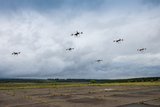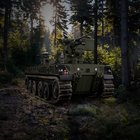UV Europe 2011: Watchkeeper finally spools up for Afghanistan
The Ministry of Defence will deploy its first Watchkeeper UAV systems to Afghanistan in April, over a year behind the original operational expectations of the British Army.
According to Maj Matt Moore, OC Watchkeeper Implementation Team and SO2 UAS HQ Director Royal Artillery, a total of three systems will be deployed in April to operate alongside Project Lydian Hermes 450s before the latter is eventually shipped out.
By October, the army then plans to deploy an additional six Watchkeeper systems which will signal the start of the drawdown of Project Lydian air vehicles. Thales is currently contracted to support Project Lydian until 2012.
However, British Army sources previously told Shephard that it had originally been hoped that Watchkeeper would deploy to Afghanistan by the end of 2010. The programme has suffered from flight trial delays although in 2009, officials had said this would not impact on the planned initial operational capability date of 2010.
According to Moore, the army started training on Watchkeeper on 16 May this year with operational field trials scheduled to take place from September to November at West Wales Airport. 'The equipment will be fielded and integrated into theatre during Q1 2012,' he continued.
Designed to provide 'timely' image intelligence (IMINT) to ground forces, Moore described the latest move to integrate the Thales I-Master GMTI/SAR radar onto the airframe, providing a range of up to 30km. Previously, Watchkeeper has flown with Elop's DcoMPASS 4 EO/IR payload.
Looking ahead to the proposed deployment, Moore urged: 'Watchkeeper has to have expeditionary and tactical mobility which is important for the fast-moving dynamic battlefield and giving a degree of organic capability for commander's requirements.'
The army is looking at deploying 'ISTAR tactical groups' on board Viking all-terrain vehicles in order to 'assist a battlegroup; assist in ISTAR and UAV planning', Moore continued. 'This provides an ability to dismount and remote equipment for use in headquarters and buildings.
However, Moore called for a common remote video terminal (RVT) on the modern day battlefield, allowing an operator to observe imagery from Watchkeeper and Predator UAVs as well as any other coalition platforms.
'Waveforms and encryption levels are different and we want one common RVT. This is still an issue and one that has not been solved by industry as yet,' he concluded. To date, the Watchkeeper programme has procured a total of five RVTs, designed to receive full-motion video feed from the air vehicle at ranges up to 10km.
More from Uncrewed Vehicles
-
![US Navy foresees an uncrewed future for its surface and underwater fleet]()
US Navy foresees an uncrewed future for its surface and underwater fleet
The service has been conducting various procurement and development efforts to integrate unmanned surface and underwater vehicles into its inventory.
-
![Ready for the race: Air separation drone swarms vs. air defence systems]()
Ready for the race: Air separation drone swarms vs. air defence systems
As the dynamics of aerial combat rapidly evolve, Chinese scientists have engineered a sophisticated air separation drone model that can fragment into up to six drones, each capable of executing distinct battlefield roles and challenging the efficacy of current anti-drone defences such as the UK’s Dragonfire laser system.
-
![Israel’s MALE UAVs ‘must adapt’ to Iranian-made air defences]()
Israel’s MALE UAVs ‘must adapt’ to Iranian-made air defences
Advancements in air defence technologies have begun to reshape aerial combat dynamics in the Middle East, as illustrated by recent events involving the Israeli Air Force and Hezbollah.
-
![Hundreds more UAS sent to Ukraine forces with thousands more on the way]()
Hundreds more UAS sent to Ukraine forces with thousands more on the way
Both sides of the Russia-Ukraine war have been using UAS for effective low-cost attacks, as well as impactful web and social media footage. Thousands more have now been committed to Ukrainian forces.
-
![AI and software companies selected for US Army Robotic Combat Vehicle subsystems]()
AI and software companies selected for US Army Robotic Combat Vehicle subsystems
The US Army has intentions to develop light, medium and heavy variants of the Robotic Combat Vehicle (RCV) as part of the branche’s Next Generation Combat Vehicle family.


























